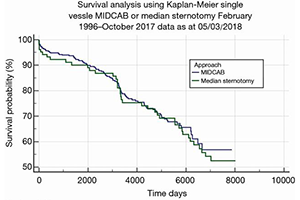Short-term clinical outcomes and long-term survival of minimally invasive direct coronary artery bypass grafting
Abstract
Background: Minimally invasive direct coronary artery bypass (MIDCAB) grafting is regarded as an alternative to conventional coronary artery bypass grafting (CABG) through full sternotomy, particularly for patients with isolated proximal left anterior descending (LAD) artery stenosis deemed unsuitable for percutaneous coronary intervention. However, the technically demanding nature of the procedure and lack of long-term published outcomes have precluded its universal adoption. We report the comparative short-term outcomes and long-term survival of MIDCAB and conventional CABG through full sternotomy for grafting of isolated LAD.
Methods: From February 1996 to October 2017, a total of 668 patients underwent MIDCAB (n=508) and full sternotomy (n=160) CABG for isolated proximal LAD stenosis. Their data were prospectively entered into the institutional cardiac surgery database (Patients Analysis & Tracking System; Dendrite Clinical Systems, Ltd, Oxford, England, United Kingdom) and analyzed retrospectively. Information on patient deaths was obtained from the institutional database and the National General Register Office for all patients.
Results: The two groups were comparable with respect to preoperative demographics and risk profile. MIDCAB was associated with longer operative time (177±32 versus 141±12 min; P=0.003). The two groups did not significantly differ with regard to other complications including operative mortality. At a mean follow-up of 12.95±0.47 years, survival was also similar.
Conclusions: This large single centre study with longest follow-up validates the status of MIDCAB as an effective strategy for grafting of LAD. However, it fails to show superiority of the minimally invasive approach compared to conventional CABG through full sternotomy.
Cover






